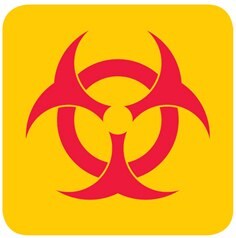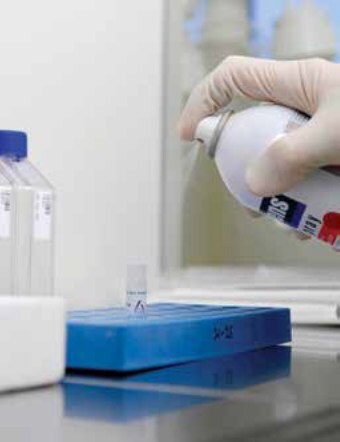Cell Culture Fundamentals: Safety Aspects of Cell Culture
ECACC Laboratory Handbook 4th Edition
Cell Culture Lab Risk Assessment
The principal goals of risk assessment are to prevent injury, protect property and avoid harm to individuals and the environment. In many countries the performance of risk assessment is a legal requirement. For example, this is the case in the UK under the Health and Safety at Work Act, UK (1974). There are also European Community directives covering Health and Safety at work. You can visit the European Agency for Safety and Health at Work for information on legislation and standards or you should contact your on-site Health and Safety representative. Consequently, risk assessments must be undertaken prior to starting any activity. The assessment consists of two elements:
- Identifying and evaluating the risks.
- Defining ways of avoiding or minimizing the risk.
For animal cell culture the level of risk is dependent upon the cell line to be used and is based on whether the cell line is likely to cause harm to humans. The different classifications are given below:
- Low Risk: Non-human/non-primate continuous cell lines, and some well characterized human continuous cell lines.
- Medium Risk: Poorly characterized mammalian cell lines.
- High Risk: Primary cells derived from human/primate tissue or blood. Cell lines with endogenous pathogens (the precise categorization is dependent upon the pathogen) – refer to ACDP guidelines, for details†. Cell lines used following experimental infection where the categorization is dependent upon the infecting agent – refer to ACDP guidelines, for details.
†Advisory Committee on Dangerous Pathogens (ACDP) (1995) Categorization of Biological Agents According to Hazard and Categories of Containment, 4th edition, HSE books, Sudbury, UK. The fifth update to the 1995 document was produced in 2013. An update to the Approved List of Biological agents was issued in 2013.
Note: The U.S. Department of Health and Human Services (Centers for Disease Control and Prevention) publishes a similar list, in its Biosafety in Microbiological and Biomedical Laboratories (BMBL) document (2009). The U.S. system uses Biological Safety Levels in place of the UK ACDP hazard groups.
A culture collection such as European Collection of Authenticated Cell Cultures (ECACC) will recommend a minimum containment level required for a given cell line based upon its risk assessment. For most cell lines the appropriate level of containment is Level 2 requiring a class 2 microbiological safety cabinet. However, this may need to be increased to containment Level 3 depending upon the type of manipulations to be carried out and whether large culture volumes are envisaged. For cell lines derived from patients with HIV or Human T-Lymphotropic Virus (HTLV), Level 3 containment is required. Containment is the most obvious means of reducing risk. Other less obvious measures include restricting the movement of staff and equipment into and out of laboratories. Good laboratory practice and good bench techniques such as ensuring work areas are uncluttered, and that reagents are correctly labelled and stored, are also important for reducing risk and making the laboratory a safe environment in which to work. The risk of exposure to aerosols or splashes can be limited by avoiding rapid pipetting, scraping and pouring. In addition, it is recommended that people working in laboratories where primary human material is used are vaccinated against Hepatitis B. Staff training and the use of written standard operating procedures and risk assessments will also reduce the potential for harm. Cell culture training courses covering the basics of tissue culture safety are offered by ECACC.
Biohazards in Cell Culture

Viruses pathogenic for humans are one of the most likely biohazards presented by cell cultures. Where infection with an agent pathogenic for humans is known or suspected, the cell culture should be handled at a containment level appropriate for the agent concerned. Other potential biohazards should also be considered. These relate to components of the cell culture medium, other adventitious agents (e.g. contaminating mycoplasmas) and cell products, some of which may be biologically active molecules with pharmacological, immunomodulating or sensitizing properties. In addition, the generation and use of modified cells–for example; hybrids, transformed cells and cells containing recombinant DNA, can be hazardous. These procedures could potentially result in the appearance of modified or reactivated viruses, novel fusion/hybrid proteins (especially in cross-species hybrids) and the expression of viral or cellular oncogenes. Laboratory workers should never culture cells derived from their own body or tissues. In vitro transformation or genetic modification could result in malignant disease or expression of an unusual pharmacologically active protein if they were to be accidentally inoculated into the donor. Therefore, human cells should be obtained from individuals having no association with the experimental work. Biohazardous waste should be disposed of according to the methods described under Waste Disposal section below.
Genetically Modified Organisms (GMOs)
The generation and use of genetically modified organisms (GMOs) should be strictly controlled and regulated. Most countries have regulatory organizations to ensure the risks posed by GMOs are minimized. For example, in the UK all institutions that carry out work using and/or generating GMOs are required by law to have a Genetic Modification Safety Committee (GMSC). Prior to any work commencing, proposals for the intended work should go through the committee and, if necessary, be approved by the Health and Safety Executive (HSE). There is a European Directive governing the regulation of GM work. It is the responsibility of the individual cell culture user and institution to ensure compliance with the regulations set by the authorities of the country in which they are operating.
Laboratory Disinfection

Methods designed for the disinfection/decontamination of culture waste, work surfaces and equipment represent important means for minimizing the risk of harm. Always wear appropriate personal protective equipment (PPE) such as gloves and eye protection when using concentrated forms of disinfectants. The selected gloves should protect against the substance being handled and meet the European standard EN374-3. Manufacturers’ charts will help to identify the best gloves for the work. The major disinfectants fall into four groups and their relative merits can be summarized as follows:
Alcohol (e.g. Ethanol, Isopropanol)
- Effective concentrations: 70% for ethanol, 60-70% for isopropanol
- Their mode of action is dehydration and fixation
- Effective against bacteria. Ethanol is effective against most viruses but not nonenveloped
- viruses
- Isopropanol is not effective against viruses
Aldehydes (e.g. Formaldehyde)
- Aldehydes are irritants, and their use should be limited due to problems of sensitization
- Should only be used in well ventilated areas
- Formaldehyde is used to fumigate laboratories. The formaldehyde is heated in a device so it will vaporize and all exposed surfaces are coated with the disinfectant.
Note: Generally, the use of aldehydes for disinfection and fumigation purposes can be hazardous. Check local regulations and with your safety advisor.
Hypochlorites (e.g. Sodium Hypochlorite)
- Good general purpose disinfectant
- Active against viruses
- Corrosive against metals and therefore should not be used on metal surfaces e.g. centrifuges
- Readily inactivated by organic matter and therefore should be made fresh daily
- Should be used at 1000ppm for general use surface disinfection, 2500ppm in discard waste pots for disinfecting pipettes, and 10,000ppm for tissue culture waste and spillages
Note: When fumigating a cabinet or room using formaldehyde, all the hypochlorites must first be removed as the two chemicals react together to produce carcinogenic products.
Cell Culture Waste Disposal
Every employer has a ‘duty of care’ to dispose of all biological waste safely in accordance with national legislative requirements. Given below is a list of ways in which tissue culture waste can be decontaminated and disposed of safely. One of the most important aspects of the management of all laboratory-generated waste is to dispose of waste regularly and not to allow biohazardous material to accumulate. The best approach is ‘little and often’. Different forms of waste require different treatment.
- Tissue culture waste (culture medium) – inactivate for at least 2 hours in a solution of hypochlorite (10,000ppm) prior to disposal to drain with an excess of water
- Contaminated pipettes should be placed in hypochlorite solution (2500ppm) overnight before disposal by incineration
- Solid waste such as flasks, centrifuge tubes, contaminated gloves, tissues, etc., should be placed inside heavy-duty sacks for contaminated waste and incinerated
- If at all possible waste should be incinerated rather than autoclaved
- Waste from specially licensed laboratories e.g. those handling genetically modified level 2 (GMO2) organisms requires specific treatment and tracking
Para seguir leyendo, inicie sesión o cree una cuenta.
¿No tiene una cuenta?